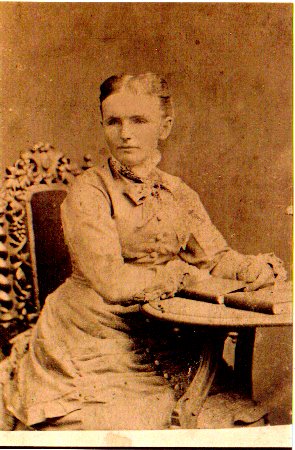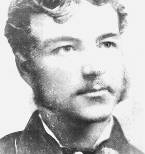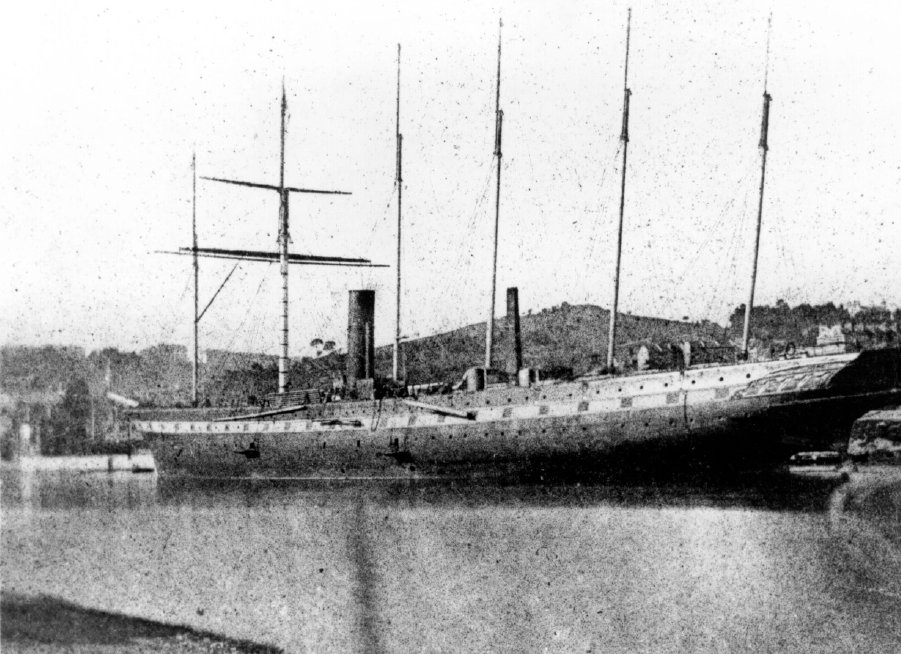| Name | Elizabeth Jane "Lilly" HUTSON |  |
| Birth | 19th May1850, Christening: 16 JUN 1850 Saint Faith, Havant, Hampshire, England | |
| Death | 1929, Heidelberg, Victoria, Age: 78 | |
| Burial | 11 Apr 1929, Leongatha Cemetery -
Baptist
Section
Unmarked graves between Collins & Hoult & Morgan |
|
| Occupation | Nursing Midwife | |
| Father | Charles HUTSON (HODSON) (1821-) | |
| Mother | Anne MANLEY (1826-) | |
| 1 | Married William Richardson BREDIN on the 28 Feb 1870, Havant, Hampshire. |
| Birth | Abt 1828/1829 |
| Death | 8 Apr 1907, Rheola, Victoria Age: 79 |
| Burial | Rheola (C of E First Row), Victoria |
| Children: | Eliza Ann (1871-1931) |
| Elizabeth (1873-1919) | |
| Charles Hawtry (1877-1954) | |
| Albert Edward (1889-1889) | |
| Myrtle (1890-1960) |
| 2 | Married Charles Henry PROSSER (SHARMAN) on 12 May 1894, 430 Bourke St, Melbourne. |
| Birth | 27 May 1860 |
| Death | 1930, Wonthaggi Hospital Age: 69 |
| Burial | Leongatha |
| Father | Charles Thomas SHARMAN (1827-1902) |
| Mother | Sarah Ann CLARK (1832-1895) |

| Children: | Harry Hutson (1895-1964) |
BIO: Eliza Jane HUTSON was born in the Southern Coastal region of England Hampshire, in a parish called Havant in 1850. Eliza Jane Hutson and her husband William Richardson Bredin left Britain on the 19 March 1870 to come to Australia on the SS Great Britain. The trip taking 57 days, arriving Friday the 20th May 1870.

After the birth of three children at or around Inglewood (Eliza Ann in 1871, Elizabeth in 1873 and Charles Hawtry in 1877), Eliza Jane appears to have "moved" to Clifton Hill (Melbourne). Whether William was with her or not is unknown at this stage. In 1889, another son Albert Edward was born to Eliza Jane and William Richardson. He died later that year at 7 months of age. Then, in 1890, Myrtle is born, also at Clifton Hill - registered as both Bredin and Hudson (sic), with father unknown on the certificate.

On 12 January 1894, Eliza Jane marries Charlie Prosser (Charles Henry Sharman) in Melbourne. Her address is stated on the marriage certificate as Tarwin, Gippsland and Charlie's as Heatherton.
Tarwin
They continued to live at Heatherton, where Henry Hutson (Harry) was born. The marriage certificate of Charlie and Eliza Jane states that she was widowed in February 1884. This is not true, as William Richardson did not die until 08 April 1907. If William Richardson is Albert Edward's father is also unknown. It is possible that they divorced (though no Victorian records of this exist), or more likely, Eliza Jane married Charlie Prosser illegally. Lilly work as one of the districts most respected Midwifes. She assisted in the birth of her grandson, Charlie Hutson Prosser when he was born during the night. The birth took place in a tent which was the first home for Harry and his bride. Charlie was taken to Leongatha Hospital the next morning.
1911 Encyclopaedia
HAVANT, a market-town in the Fareham parliamentary division of
Hampshire, England, 67 m. SW. from London by the London & South
Western and the London, Brighton & South Coast railways. Pop. of
urban district (iooi), 3837. The urban district of Warblington, i m.
S.E. (pop. 3639), has a fine church, Norman and later, with traces of
pre-Norman work, and some remains of a Tudor castle. Havant lies in a
flat coastal district, near the head of Langstone Harbour, a wide
shallow inlet of the English Channel. The church of St Faith was
largely rebuilt in 1875, but retains some good Early English work.
There are breweries and tanneries, and the manufacture of parchment is
carried on.
Havant's parish church is dedicated to St Faith, a young girl of
Aquitaine in France, who was martyred A.D.290 during the Diocletian
persecution. Whilst unrecorded in the Doomsday Survey, there are other
references to the church about this time. The early Gothic style is
retained despite being rebuilt and restored several times.
The churchyard had always been Havant's principal burial ground and by
1850 it was estimated to hold the remains of over 20,000 souls. Its
level had risen to well above that of the surrounding streets and as it
became impossible to make new burials without disturbing the remains of
others, a new cemetery was established on land in New Lane which had
been given by Sir George Staunton. One acre was allocated for the
church and a quarter of an acre for dissenters. The cemetery was
expanded in 1896.
By 1800 there were several shops and a church house in front of the
church in West Street; most of these were demolished at some time but
one building remained at the corner of Homewell by the churchyard until
the 1920s. The church house was founded for the use of the poor and
became a meeting place for social events. Spits, crocks and other
utensils for cooking were provided by the parish free of charge and
could be obtained from here. The building was later converted into an
almshouse, the last occupants being two aged paupers by the names of
Bishop and Carpenter.
Examination of the records of the Court Leet, the manorial court which
dealt with criminal offences, gives some idea of lawlessness in the
17th and 18th Centuries. Havant possessed the usual equipment for the
punishment of offenders; the ducking stool, stocks, pillory, whipping
post and the lock up. Anyone sentenced to be confined in one of these
appliances would become the target of abuse and missiles from their
fellow townspeople.
The pastureland around Havant and on the Downs was ideal for sheep
farming which in turn supported a number of other industries. Wool was
made into cloth and a thriving trade was established. However, during
the 16th Century, Parliament introduced a new standard size to which
cloth had to be manufactured and as this could not be complied with
locally, the industry went into decline. The sheep also provided
essential food and their skins were used for the manufacture of
parchment and leather.
Havant parchment was held in very high esteem on account of its
whiteness compared with all other parchment which tended to be yellow.
It was made from the inner layer of the sheep's skin which was
processed over several weeks before being finished. Throughout
manufacture large quantities of spring water were used and it was the
unique properties of this water which were responsible for the
parchment's whiteness.
Although parchment had been made in Havant for hundreds of years there
is no evidence to show that it was produced on any large scale until
the 1850s. The last parchment yard, Stallard's in Homewell, closed in
1936.
The outer layer of the sheep's skins, together with the skins of other
animals, went to various tanneries in the town for making into leather.
This was another industry requiring a large volume of water. It
flourished by supplying boot, shoe, clothes and harness-making trades.
The making of leather and high quality gloves continued into the 1960s,
much of the latter work being carried out in employees' homes.
Brewing was another thriving local industry also reliant on the
abundant supply of virtually pure water. In 1855 there were four
breweries and nine malt houses in the town and in addition a number of
Beer Houses brewed their own supply. The barley for the malt as well as
the hops were grown locally. The last brewery was Biden's which was
situated in West Street next to the Prince of Wales. When it closed in
the 1920s it was converted into a laundry, later becoming the Home
Service Laundry, making exploitative use of the brewery's old well.
Another laundry, the
